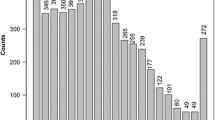Abstract
Glutathione S-transfera ses (GSTs) constitute a large protein family. Some of them are proved to be associated with biphenyl metabolism. In this study, we described a homolog of GST gene inLactobacillus casei Zhang that revealed by genome analysis. The GST gene itself as well as the adjacent gene context was highly conserved among differentL. casei isolates. Phylogenetic investigation suggested that the GST gene was acquired via horizontal gene transfer event, possibly from gamma subdivision. Additional survival experiment indicated that it may not benefit theL. casei host for growing in the presence of biphenyl. It was for the first time discovered that GST was encoded byLactobacillaceae species.
Similar content being viewed by others
References
Allocati N., Federici L., Masulli M., Di Ilio C. (2009). Glutathione transferases in bacteria. FEBS J., 276: 58–75.
Altschul S.F., Madden T.L., Schaffer A.A., Zhang J., Zhang Z., Miller W., Lipman D.J. (1997). Gapped BLAST and PSI-BLAST: a new generation of protein database search programs. Nucleic Acids Res., 25: 3389–3402.
Bartels F., Backhaus S., Moore E.R., Timmis K.N., Hofer B. (1999). Occurrence and expression of glutathione-S-transferase-encoding bphK genes inBurkholderia sp. strain LB400 and other biphenyl-utilizing bacteria. Microbiology, 145: 2821–2834.
Blattner F.R., Plunkett G., 3rd Bloch C.A., Perna N.T., Burland V., Riley M., Collado-Vides J., Glasner J.D., Rode C.K., Mayhew G.F., et al. (1997). The complete genome sequence ofEscherichia coli K-12. Science, 277: 1453–1474.
Clamp M., Cuff J., Searle S.M., Barton G.J. (2004). The Jalview Java alignment editor. Bioinformatics, 20: 426–427.
Fortin P.D., Horsman G.P., Yang H.M., Eltis L.D. (2006). A glutathione S-transferase catalyzes the dehalogenation of inhibitory metabolites of polychlorinated biphenyls. J. Bacteriol., 188: 4424–4430.
Kozaki M., Uchimura T., Okada S. (1992). Laboratory Manual of Lactic Acid Bacteria, Asakura Book Store, Tokyo.
Kurtovic S., Shokeer A., Mannervik B. (2008). Diverging catalytic capacities and selectivity profiles with haloalkane substrates of chimeric alpha class glutathione transferases. Protein Eng. Des. Sel., 21: 329–341.
Lloyd-Jones G., Lau P.C. (1997). Glutathione S-transferaseencoding gene as a potential probe for environmental bacterial isolates capable of degrading polycyclic aromatic hydrocarbons. Appl. Environ. Microbiol., 63: 3286–3290.
Mulder N.J., Apweiler R., Attwood T.K., Bairoch A., Bateman A., Binns D., Bradley P., Bork P., Bucher P., Cerutti L., et al. (2005). InterPro, progress and status in. Nucleic Acids Res., 33: D201–205.
Ohtsubo Y., Delawary M., Kimbara K., Takagi M., Ohta A., Nagata Y. (2001). BphS, a key transcriptional regulator of bph genes involved in polychlorinated biphenyl/biphenyl degradation inPseudomonas sp. KKS102. J. Biol. Chem., 276: 36146–36154.
Tamura K., Dudley J., Nei M., Kumar S. (2007). MEGA4: Molecular Evolutionary Genetics Analysis (MEGA) software version 4.0. Mol. Biol. Evol., 24: 1596–1599.
Vuilleumier S. (1997). Bacterial glutathione S-transferases: what are they good for? J. Bacteriol., 179: 1431–1441.
Vuilleumier S., Pagni M. (2002). The elusive roles of bacterial glutathione S-transferases: new lessons from genomes. Appl. Microbiol., 58: 138–146.
Yan F., Yang W.K., Li X.Y., Lin T.T., Lun Y.N., Lin F., Lv S.W., Yan G.L., Liu J.Q., Shen J.C., et al. (2008). A trifunctional enzyme with glutathione S-transferase, glutathione peroxidase and superoxide dismutase activity. Biochim. Biophys. Acta., 1780: 869–872.
Zhang W., Yu D., Sun Z., Chen X., Bao Q., Meng H., Hu S., Zhang H. (2008a). Complete nucleotide sequence of plasmid plca36 isolated fromLactobacillus casei Zhang. Plasmid., 60: 131–135.
Zhang W., Yun Y., Sun T., Menghe B., Zhang H. (2008b). Isolation and identification of dominant microorganisms involved in naturally fermented goat milk in Haixi region of Qinghai, China. Ann. Microbiol., 58: 213–217.
Author information
Authors and Affiliations
Corresponding authors
Additional information
These authors contributed equally to this work.
Rights and permissions
About this article
Cite this article
Zhang, W.Y., Yu, D.L., Sun, Z.H. et al. Preliminary analysis of glutathione S-transferase homolog fromLactobacillus casei Zhang. Ann. Microbiol. 59, 727–731 (2009). https://doi.org/10.1007/BF03179215
Received:
Accepted:
Issue Date:
DOI: https://doi.org/10.1007/BF03179215




